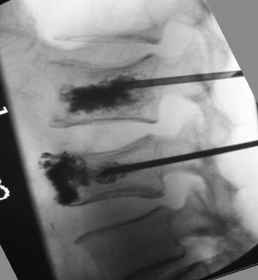Cement diffusion real-time simulation (CDRTS)
Thesis by: tbaAdvisor: Prof. Dr. Nassir Navab
Supervision by: Patrick Wucherer, Philipp Stefan
Overview


 X-Ray image: https://www.nuh.com.sg/uohc/about-us/about-us/department-of-orthopaedic-surgery/spine-surgery/minimally-invasive-spine-mis-surgery.html
X-Ray image: https://www.nuh.com.sg/uohc/about-us/about-us/department-of-orthopaedic-surgery/spine-surgery/minimally-invasive-spine-mis-surgery.html
Topic
Development of realtime computational model for cement diffusion in fractured vertebra.Background
Procedures like vertebroplasty or kyphoplasty aim at augmentation of fractured bone with bone cement in order to stabilize it. During these procedures, Polymethylmethacrylate (PMMA) bone cement is injected directly into the cancellous structure of the fractured bone. The complication rate of these procedures is markedly high, with the most common complication being cement extravasation, i.e. cement leakage. Although the majority of these complications are clinically asymptomatic, clinical adverse effects can be devastating. There is therefore an interest in reducing this risks and maximize outcome by improving preoperative planning and training of the procedure. Planning and training would substantially benefit from an accurate, real-time simulation of the cement diffusion process.Related work
An approach towards simulation of fluid flow inside a porous medium has been proposed by Lenaerts et al. [Lenaerts2008]. Their approach uses a mesh-free smoothed particle hydrodynamics (SPH) method and treats porous flow at a macroscopic scale, modeling cavities and pores of a region in the volume implicitly as a parameter of a porous particle. This has the advantage that the porous material can be deformed and absorption or emission at the boundary of the deformable body can be easily handled. Simulation of bone cement diffusion in osteoporotic bone using a SPH model based on CT imaging data has been done by [Basafa2010]. However, both methods do not simulate the diffusion process in real-time. Moreover, variable viscosity and temperature, i.e. in case of the bone cement due to the exothermic polymerization process, have not been considered. Yet SPH-based simulation of particle diffusion processes with varying viscosity and temperature at interactive frame rates using GPU-accelerated algorithms is feasible even with high particle counts [Hérault2011].Contribution
This project contributes:- Pre-operative planning
- Training of vertebroplasty
- A complete simulation of a minimally invasive surgery (MIS) called 'vertebroplasty'.
Tasks/Sub-projects
Extension of the existing simulation framework:- Improvement of simulation model
- Integration of X-Ray dataset
- Visualization of cement 'cloud' from particle data
What do we offer
- Experience different fields of research in computer science: Visualization, Software Engineering, Real-time Simulation, GPU Programming
- Potentially the co-authorship on research papers submitted to prestigious conferences/journals (depending on student performance)
- We offer an intensive supervision, but initiative is very welcome. Working environment will be provided at the NARVIS lab or the simulation center Institut für Notfall-und Medizinmanagement (INM).
Requirements
- Interest in interdisciplinary research field
- Basic C/C++ knowledge
- CUDA/GPU programming experience would be preferable
Contact
Literature
- [Lenaerts2008] T. Lenaerts, B. Adams, and P. Dutré, ‘Porous Flow in Particle-based Fluid Simulations’, in ACM SIGGRAPH 2008 Papers, New York, NY, USA, 2008, pp. 49:1–49:8.
- [Basafa2010] E. Basafa, Y. Otake, M. D. Kutzer, R. S. Armiger, and M. Armand, ‘A Particle-Based Model for Prediction of Cement Diffusion during Osteoporotic Hip Augmentation Surgery: Theory and Validation’, Proceedings ASME International Mechanical Engineering Conference & Exposition, p. 12–18, 2010.
- [Hérault2011] A. Hérault, G. Bilotta, A. Vicari, E. Rustico, and C. D. Negro, ‘Numerical simulation of lava flow using a GPU SPH model’, Ann. Geophys., vol. 54, no. 5, Dec. 2011.
| ProjectForm | |
|---|---|
| Title: | Cement diffusion real-time simulation |
| Abstract: | |
| Student: | tba |
| Director: | Prof. Dr. Nassir Navab |
| Supervisor: | Patrick Wucherer, Philipp Stefan |
| Type: | DA/MA/BA |
| Area: | |
| Status: | finished |
| Start: | |
| Finish: | |
| Thesis (optional): | |
| Picture: | |